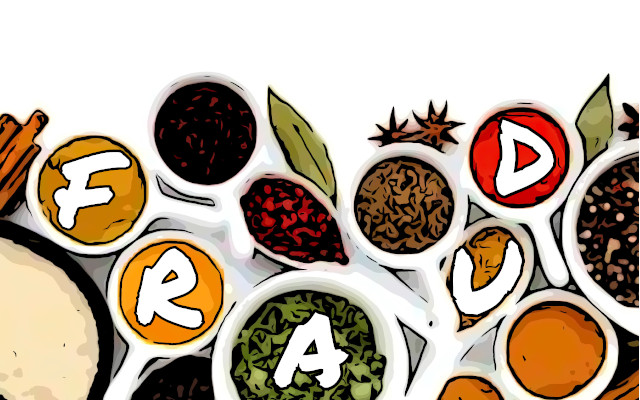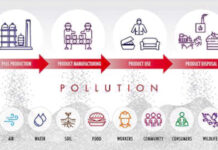The largest survey conducted in Europe on the authenticity of herbs and spices reveals that nearly 1 in 5 products are adulterated with various contaminants and allergens. Prohibited dyes, foreign plant species, powders and chalk, among others.
1,900 samples (including 99 from Italy) were collected from 21 member states-as well as Norway and Switzerland-and analyzed by theJoint Research Center (JRC). As part of the extraordinary control plan launched by the European Commission in 2019. (1)
Contaminated spices and herbs, production and consumption in Europe
Europe produces about 100,000 tons a year of herbs and spices. And it imports more than three times as much – spices, mostly – from Asia, Africa, Latin America and the Caribbean.
The wide use in culinary preparations-partly to reduce salt consumption-is due to the food industry (70-80%), followed by retail (15-25%) and catering (5-10%).
Aromatic herbs and spices are also used in the production of food supplements, cosmetics, and additives in animal feed.
Extraordinary control plan
The survey focused on cumin, turmeric, oregano, paprika/pepper, pepper, and saffron. In fact, these species have been identified as having a higher risk of adulteration.
Nearly 10,000 laboratory tests revealed irregularity in 17 percent of the samples (323 out of 1,885).
Food fraud on herbs and spices, the EU ranking
The ranking of food frauds on herbs and spices, to follow, is worrisome for the recurrence of hidden allergens:
– oregano (48%). It is adulterated, almost every other time, with foreign vegetables such as olive and myrtle leaves,
– pepper (17%). Peppercorns are replaced or mixed with papaya seeds, but also with starches and allergens such as buckwheat, other grains, and mustard seeds,
– cumin (14%). The most common fraud is the presence of mahaleb, a species closely related to almonds, peanut shells and almond husks.
Banned dyes and heavy metals
The list goes on with frauds also made with banned dyes, as well as heavy metal contamination:
– turmeric (11%). Fraud historically involves the addition of azo dyes, inorganic materials (yellow chalk, lead chromate) and fillers (corn or rice flour, etc.). Out of 316 samples, one contaminated with Sudan I, one with heavy metals (lead, 2 g/kg, and chromium, 0.5 g/kg), two with tartrazine,
– saffron (11 percent). Frequent adulteration with azo dyes and substitutions with less valuable botanical ingredients (safflower, turmeric, etc.),
– chili and paprika (6%). In addition to tomato peels, Sudan I (a carcinogenic and genotoxic industrial dye that was the subject of a systemic fraud of global magnitude last decade) has been detected. As well as azo dyes, which are themselves not allowed(Allura Red, Bixin, Azorubin and Sunset Yellow).
Fraud and contamination out of control
The European Commission notes the difficulty in identifying the origin of fraud. The supply chain is long and complex, fragmented. And even in the EU, as the data show, controls are inadequate.
‘Most spices are produced in countries where certain post-harvest processes such as drying and cleaning can take place before being shippedto the importing country, where they are further cleaned and sanitized before being packaged and distributed to other food companies or for retail consumption .
Fraudulent manipulation can occur at any stage, and the more often material is transferred from one operator to another, the greater the likelihood of fraud,’ the research authors note.
Perhaps someone someday, in this as in other critical supply chains, will begin to consider the value of
blockchain
public. Also to track, with incorruptible technology, material flows and manufacturing processes.
Marta Strinati
Notes
(1) Maquet, A., Lievens, A., Paracchini, V., Kaklamanos, G., De La Calle Guntinas, M.B., Garlant, L., Papoci, S., Pietretti, D., Ždiniaková, T., Breidbach, A., Omar Onaindia, J., Boix Sanfeliu, A., Dimitrova, T. and Ulberth, F., Results of an EU wide coordinated control plan to establish the prevalence of fraudulent practices in the marketing of herbs and spices, EUR 30877 EN, Publications Office of the European Union, Luxembourg, 2021, ISBN 978-92-76-42979-1 (online), doi:10.2760/309557 (online), JRC126785. https://publications.jrc.ec.europa.eu/repository/handle/JRC126785
Professional journalist since January 1995, he has worked for newspapers (Il Messaggero, Paese Sera, La Stampa) and periodicals (NumeroUno, Il Salvagente). She is the author of journalistic surveys on food, she has published the book "Reading labels to know what we eat".








